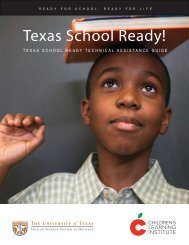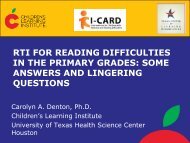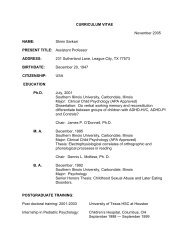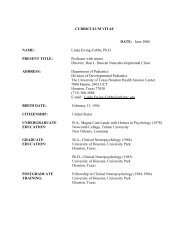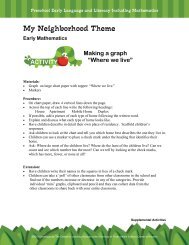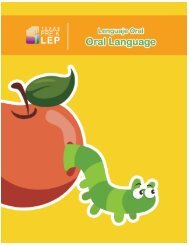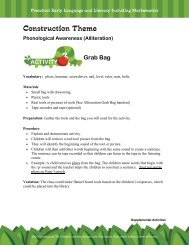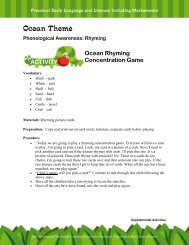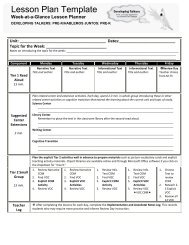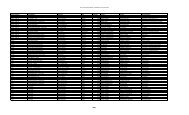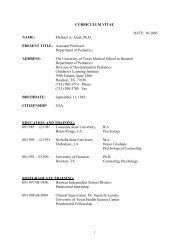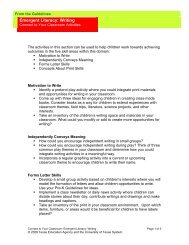ACTIVITY 2 Shapes - Children's Learning Institute
ACTIVITY 2 Shapes - Children's Learning Institute
ACTIVITY 2 Shapes - Children's Learning Institute
Create successful ePaper yourself
Turn your PDF publications into a flip-book with our unique Google optimized e-Paper software.
CIRCLE<br />
Preschool Early Language and<br />
Literacy Including Mathematics<br />
C-PALLS +<br />
M ath Activities
Preschool Early Language and Literacy Including Mathematics<br />
Rote Counting<br />
<strong>ACTIVITY</strong> 1<br />
Vocabulary: number names (1-20), count<br />
Materials: None needed<br />
Directions<br />
• Ask the children to stand.<br />
• Say, “We are going to play a counting game. I will count to five, and then clap. Join in<br />
when you are ready. One, two, three, four, five (clap). One, two, three, four, five (clap).”<br />
• Continue until all the children have joined in for several rounds.<br />
• Tell the children the new number that you will count to and repeat the game.<br />
• Once children have mastered 1-10, continue with numbers 11-20.<br />
<strong>ACTIVITY</strong> 2<br />
Count Clapping<br />
Number Count<br />
Clapping<br />
Vocabulary: number names (1-20), count<br />
Materials: number cards (1-10)<br />
Directions<br />
• Ask the children to stand.<br />
• Introduce activity by saying, “We are going to play a counting game with numbers.”<br />
• Show a number card and say, “I am counting to this number. When I get to the number on<br />
the card, I will clap. Join in when you are ready.”<br />
• Show number 4 card. “One, two, three, four” (clap as you are saying four).<br />
• Continue for several rounds.<br />
• Once children have mastered 1-10, continue with numerals 11-20.<br />
Extension: As children learn to count to a number, add objects for one to one<br />
correspondence. Have them clap when they reach the target number.<br />
©2009 Developed by The Children’s <strong>Learning</strong> <strong>Institute</strong> at the University of Texas Health Science Center at Houston
Preschool Early Language and Literacy Including Mathematics<br />
<strong>ACTIVITY</strong> 3<br />
Number Songs<br />
Vocabulary: number names (1-20)<br />
Materials: pocket chart, sentence strips (with chants written on them), pictures or felt pieces<br />
Directions<br />
Using the listed chants, sing with the children. Show the addition or subtraction of the<br />
characters in the chants with pictures of the characters, objects or the children themselves to<br />
represent the characters.<br />
Chants:<br />
Five Little Ducks<br />
Traditional<br />
10 in the Bed<br />
There were ___ in the bed<br />
And the little one said,<br />
“Roll over! Roll over!”<br />
So they all rolled over<br />
And one fell out!<br />
“5 Little Monkeys”<br />
Five Little Monkeys Jumping on the Bed<br />
by Eileen Christelow<br />
“Bats”<br />
1 little bat says E,<br />
2 little bats say E,E,<br />
3 little bats say E,E,E,<br />
As they hang upside down in the tree.<br />
©2009 Developed by The Children’s <strong>Learning</strong> <strong>Institute</strong> at the University of Texas Health Science Center at Houston
Preschool Early Language and Literacy Including Mathematics<br />
Shape Naming<br />
<strong>ACTIVITY</strong> 1<br />
Shape Freeze<br />
Vocabulary: circle, square, triangle, rectangle, inside, outside<br />
Materials: masking tape, CD/cassette player, lively music<br />
Directions<br />
• Use the masking tape to create large circle, square, triangle, and rectangle shapes on the<br />
floor of a large open area in your room, school or center. Be sure the shapes are big<br />
enough for several children to move around in comfortably.<br />
• Make enough shapes so that a large group can play.<br />
• Tell the children to move to the music jumping in and out of the shapes as the music plays<br />
and stop when you call “Freeze!”<br />
• When the children freeze identify those that are inside a shape and those that are outside a<br />
shape. For example, “Paul and Nancy are inside the circle. Kerry and Juan are outside the<br />
circle. Gary is inside the triangle, etc.”<br />
• Restart the music and repeat the game for several rounds.<br />
Extensions<br />
• As the children learn the game instead of stating who is inside or outside the shapes, ask<br />
the children, “Who is inside the circle?” “Who is outside the rectangle?” and so on.<br />
• Take this activity outside. Draw shapes with chalk on the sidewalk. (Some centers/schools<br />
will allow spray painting the shapes on the grass or dirt. Be sure to obtain permission.)<br />
• Have the children walk outside the shapes until you say a shape name.<br />
• Then the children run to the shape. (Explain safety issues with children prior to<br />
playing this activity.)<br />
©2009 Developed by The Children’s <strong>Learning</strong> <strong>Institute</strong> at the University of Texas Health Science Center at Houston
Preschool Early Language and Literacy Including Mathematics<br />
<strong>ACTIVITY</strong> 2<br />
<strong>Shapes</strong><br />
Vocabulary: circle, triangle, square, rectangle, oval, octagon, trapezoid, etc.<br />
Materials<br />
• cardboard /construction paper shapes<br />
• glue<br />
• paper to create picture on<br />
• spinner with shapes (Teacher made by using a spinner and drawing shapes on it.)<br />
• a number generator (die)<br />
Directions<br />
• The children compose pictures using a specific number of shapes.<br />
• Using a spinner divided and labeled with shapes and a die with dots from 1 to 6, the children<br />
will spin the spinner and roll the die.<br />
• The die gives the children the number of shapes to collect.<br />
• The spinner gives the shape. (A child who spins a triangle and rolls a 3 will get 3 triangles.)<br />
• Have the children spin and roll two times.<br />
• After collecting the shapes, have the children make a picture and describe their constructions<br />
using shape words.<br />
• Label the pictures with the children.<br />
Extensions: Ask the children to share their picture with a friend and describe to the friend the<br />
shapes used. Once I was a shape, now I am a … Children use construction paper shapes to create an<br />
object by drawing additional features. Example: Glue a triangle on a piece of paper and add a circle<br />
to the top to create a hat.<br />
©2009 Developed by The Children’s <strong>Learning</strong> <strong>Institute</strong> at the University of Texas Health Science Center at Houston
Preschool Early Language and Literacy Including Mathematics<br />
<strong>ACTIVITY</strong> 3<br />
Vocabulary: shape names, sides<br />
Materials<br />
• shape matching cards with attribute block shapes<br />
• attribute blocks<br />
Directions<br />
• Pile the attribute blocks on the table.<br />
Shape Matching<br />
• Using the shape attribute blocks, teach the children the names of the shapes. “Let’s look at<br />
the blocks in our pile.” Pick up a block, “Look, this block has 3 sides. It’s a triangle. Can<br />
you find another triangle?”<br />
• Continue teaching all the different shapes names. Introduce the shape matching cards. “I<br />
have cards with pictures of shapes. Let’s see if we remember their names.” Review all the<br />
cards.<br />
• Have the children match the blocks with the picture cards. Ask ,“Why did you pick that<br />
one? How many sides does the picture have? How many sides does the block have?”<br />
Extension: Place all the attribute blocks in a bag and have the children choose a block and find<br />
a match.<br />
©2009 Developed by The Children’s <strong>Learning</strong> <strong>Institute</strong> at the University of Texas Health Science Center at Houston
Preschool Early Language and Literacy Including Mathematics<br />
Number Discrimination<br />
<strong>ACTIVITY</strong> 1<br />
Vocabulary: number, letter, object name<br />
Materials: numbers, letters, other sorting materials like bears<br />
Directions<br />
• Place one number, several letters and several sorting items (a total of 5 to 7) on a table.<br />
• Tell the children, “Let’s think about what each of these are called.” Point to each object and<br />
name it, “This is a letter. This is a bear. This is a number.”<br />
• Mix up the objects.<br />
• Ask the children to point and name each of the objects.<br />
• Next, ask the children to point specifically to the number saying, “show me the number!!”.<br />
Extension<br />
• Increase the number of objects.<br />
• Have the children name the specific number.<br />
• Make a picture with 2 to 3 numbers, 2 to 3 letters, and 2 to 3 symbols or pictures.<br />
• Have the children point to the numbers.<br />
<strong>ACTIVITY</strong> 2<br />
Show Me the<br />
Number<br />
Looking at<br />
Numbers<br />
7<br />
Vocabulary<br />
• numbers<br />
• same, different<br />
• straight lines, slanted lines, curves, circles<br />
Materials: plastic numbers or number cards<br />
Directions<br />
• Show the numbers 1 and 9. “Let’s look at these two numbers. They both have straight lines.<br />
This is the number one. It just has a straight line. This is the number nine. It has a straight<br />
line and a circle on the side at the top.”<br />
• Have the children look at other numbers and make comparisons with the attributes of the<br />
other numbers, pointing out the features of the numerals.<br />
©2009 Developed by The Children’s <strong>Learning</strong> <strong>Institute</strong> at the University of Texas Health Science Center at Houston
Preschool Early Language and Literacy Including Mathematics<br />
<strong>ACTIVITY</strong> 3<br />
Scavenger Hunt<br />
Vocabulary: number names<br />
Materials<br />
• magazines/newspapers/pictures from the Internet<br />
• scissors, glue<br />
• chart paper<br />
Directions<br />
• Have the children go on a scavenger hunt in magazines or newspapers to find numbers.<br />
• Children cut out what they find and paste on charts labeled with “Look at Our Number<br />
Hunt” or “WOW, I found a _____.”<br />
• Discuss with the children what they found and verify that the children found the correct<br />
numbers.<br />
Extension: Post the charts in the writing center and/or math center so that the children can<br />
use the numbers in their writing.<br />
©2009 Developed by The Children’s <strong>Learning</strong> <strong>Institute</strong> at the University of Texas Health Science Center at Houston
Preschool Early Language and Literacy Including Mathematics<br />
Number Naming<br />
<strong>ACTIVITY</strong> 1<br />
Number<br />
Recognition<br />
Vocabulary: number names (1-20), count<br />
Materials<br />
• number cards (1-20)<br />
• objects to count (up to 20)<br />
Directions<br />
• Show a number card, and say, “This is the number ___. Let’s move counters as we count to<br />
this number.”<br />
• Move a counter as everyone counts together.<br />
• “There are _________ counters here and that is what this number tells us.”<br />
Extension: Have the children march in place and count to the number that is being shown.<br />
<strong>ACTIVITY</strong> 2<br />
Touch the<br />
Number<br />
Vocabulary: number names, number line<br />
Materials: number line<br />
Directions<br />
• Fold the number line in half to show numbers 1-10 and secure, by taping all sides to the floor.<br />
• Have a small group (2 to 3 children) stand beside the number line.<br />
• Call out a number for the children.<br />
• If they know the number, they touch the number on the number line.<br />
• If a child doesn’t know the number, show them the number so that they can touch it.<br />
• Continue calling out numbers for several rounds.<br />
• As children become more familiar with numbers 1-10, unfold the number line to show<br />
numbers 11-20 and play the same game.<br />
Extension: Call out a number and have the children hop to the number, counting out loud as<br />
they hop. Play “Guess my Number”. Give clues about the numbers you want the children to locate.<br />
Ex. I’m thinking of a number that is more than 2 and less than 4. What is it?<br />
©2009 Developed by The Children’s <strong>Learning</strong> <strong>Institute</strong> at the University of Texas Health Science Center at Houston
Preschool Early Language and Literacy Including Mathematics<br />
<strong>ACTIVITY</strong> 3<br />
Number Line<br />
Dance<br />
Vocabulary: number names<br />
Materials<br />
• bear counters<br />
• number cards<br />
Directions<br />
• Give each child a pile of bear counters.<br />
• Tell the children that the bears are dancing the Congo (any line dance name is okay).<br />
• Hold up a number card and ask the children to make a dance line with that number of<br />
bears.<br />
• Once they line up the bears, have them count the bears out loud to check their work. Be<br />
sure to connect the number the children say to the number card you are showing.<br />
• Continue to play this game for several numbers.<br />
• Start with numbers 1-5. As the children become comfortable with the smaller numbers,<br />
add the larger numbers.<br />
Extension: Have the children suggest other things for the bears to do, such as playing<br />
soccer. Use the suggestion from the children to line up the bears. For example, “8 bears playing<br />
soccer.”<br />
©2009 Developed by The Children’s <strong>Learning</strong> <strong>Institute</strong> at the University of Texas Health Science Center at Houston
Preschool Early Language and Literacy Including Mathematics<br />
Shape Discrimination<br />
<strong>ACTIVITY</strong> 1<br />
<strong>ACTIVITY</strong> 2<br />
<strong>Shapes</strong> Puzzles<br />
Vocabulary: rectangle, circle, square, triangle, rhombus (diamond)<br />
Materials<br />
• shapes game board (Using shapes of different sizes and positioned in different directions.<br />
Make a game board.)<br />
• Matching shape cut outs for the game board<br />
Directions<br />
• Have the children match the different sized/oriented shapes on the puzzle board.<br />
• Help the children gain the understanding that changing the orientation or direction of a<br />
shape does not change the shape name.<br />
<strong>Shapes</strong> Similarities<br />
Vocabulary: shape names, same, different, color, size<br />
Materials: attribute blocks<br />
Directions<br />
• Using the attribute blocks arrange several shapes (use at least three that are the same size,<br />
shape and color) on a table.<br />
• Place a total of 6 shapes on the table.<br />
• Model this activity for the children by saying, “I am going to put the shapes that are the same<br />
color in a pile. ”<br />
• Place the shapes that are the same color together in a pile. “I put the ones that are the same<br />
color in a pile together.”<br />
• Put all the shapes back into the same pile. “Now I am going to pick the ones that are the same<br />
shape.” Put the shapes that are the same, regardless of color, into a pile. “This time I put the<br />
ones together that are the same shape. It didn‛t matter what color or size they were, I was just<br />
paying attention to the shape.”<br />
• Put all the shapes back into the same pile.<br />
• Ask the children to pick out the ones that are the same. Ask, “Why did you pick those? What<br />
is the same about the objects? What is different about the ones you did not pick?”<br />
• Record the responses of the children.<br />
©2009 Developed by The Children’s <strong>Learning</strong> <strong>Institute</strong> at the University of Texas Health Science Center at Houston
Preschool Early Language and Literacy Including Mathematics<br />
<strong>ACTIVITY</strong> 3<br />
Making New <strong>Shapes</strong><br />
Vocabulary: up, down, turn, flip, slide<br />
Materials: cardboard teacher-made shapes or shape blocks (geoblocks)<br />
Directions<br />
• In this activity, children play with shapes to combine them into other shapes. Show the<br />
children two triangles. Tell the children that these are two triangles. Point to the sides and<br />
have the children count with you.<br />
• Take the two triangles and place them together, saying, “When I take these two triangles<br />
and I turn one of them so that it will fit beside the first one, I can make a<br />
rectangle.” (Make sure that the two triangles are the same size and shape and will fit<br />
together to make a rectangle before doing this with the children.)<br />
• Model putting together two squares to make a rectangle.<br />
• Have the children practice combining shapes to make new shapes.<br />
• This activity can also be used with shapes cut from paper or plastic lids.<br />
Extension: Have the children make other shapes using two or three shapes.<br />
©2009 Developed by The Children’s <strong>Learning</strong> <strong>Institute</strong> at the University of Texas Health Science Center at Houston
Preschool Early Language and Literacy Including Mathematics<br />
Set Counting<br />
<strong>ACTIVITY</strong> 1<br />
Number Count<br />
Clapping<br />
Vocabulary: number names (1-20), count<br />
Materials: number cards (1-10)<br />
Directions<br />
• Ask the children to stand.<br />
• Introduce activity by saying, “We are going to play a counting game with numbers.”<br />
• Show a number card and say, “I am counting to this number. When I get to the number on<br />
the card, I will clap. Join in when you are ready.”<br />
• Show number 4 card. “One, two, three, four” (clap as you are saying four).<br />
• Continue for several rounds.<br />
• Once children have mastered 1-10, continue with numerals 11-20.<br />
Extension: As children learn to count to a number, add objects for one to one<br />
correspondence. Have them clap when they reach the target number.<br />
©2009 Developed by The Children’s <strong>Learning</strong> <strong>Institute</strong> at the University of Texas Health Science Center at Houston
Preschool Early Language and Literacy Including Mathematics<br />
<strong>ACTIVITY</strong> 2<br />
Making Sets<br />
Vocabulary: set, number names 1-20, how many?<br />
Materials<br />
• One ice cube tray or egg carton per child<br />
• Small bears that fit into the compartments (each child has a pile of six bears of the same<br />
color)<br />
Directions<br />
• To model the skill, tell the children, “I want you to make a set of bears. I am going to<br />
make a set first. Watch me. I will take my bears out of my pile and put them in the tray to<br />
make a set of three bears.” Place the bears in the tray as you count, “One, two, three. I<br />
have a set of three bears. How many bears do I have?” Children respond.<br />
• Now have each child make a set of four bears. Tell the children, “Remember to take your<br />
bears out of your pile one at a time and count each one as you put it in the tray.” Each<br />
child takes their bears out of their pile one at a time and verbally counts them as they<br />
place them in the tray. Provide assistance with number words and placing the bears in the<br />
tray as needed. Ask each child, “Did you make a set of four bears?” Have the children<br />
check themselves by counting again. Return the bears to the pile.<br />
• Now have the children make a set of six bears. Remind the children to take their bears out<br />
of the pile one at a time and count each one as they put it in the tray. Each child takes their<br />
bears out of their pile one at a time and verbally counts them as they place them in the<br />
tray. Provide assistance with number words and placing the bears in the tray as needed.<br />
Ask each child, “Did you make a set of six bears?” Have the children check themselves by<br />
counting again.<br />
Extension: Increase the number of objects in the sets<br />
©2009 Developed by The Children’s <strong>Learning</strong> <strong>Institute</strong> at the University of Texas Health Science Center at Houston
Preschool Early Language and Literacy Including Mathematics<br />
<strong>ACTIVITY</strong> 3<br />
Matching Numbers<br />
and Sets<br />
Vocabulary: number names, match, set, how many?<br />
Materials: 20 paper plates- Number one set of plates consecutively 1-10; on the other set of<br />
plates place dots for each number 1-10. (Since the children are looking for partners, be sure that<br />
you have the matching number pairs. Increase the numbers to 20 as children learn bigger<br />
quantities).<br />
Directions<br />
• Show the children a plate with a number on it and another plate with the matching number<br />
of dots on it. Count the dots and say the number. Explain to children that the number<br />
matches the set because it tells how many dots there are.<br />
• Give each child a plate.<br />
• Have the children walk around and find their partner, counting the dots and saying the<br />
number names.<br />
• Mix the plates and play again.<br />
Extension<br />
• Give each child a plate.<br />
• Have the children collect that number of objects.<br />
• After collecting the objects, have the children write their number on a card and label the<br />
objects collected with the number.<br />
©2009 Developed by The Children’s <strong>Learning</strong> <strong>Institute</strong> at the University of Texas Health Science Center at Houston
Preschool Early Language and Literacy Including Mathematics<br />
Operations<br />
<strong>ACTIVITY</strong> 1<br />
<strong>ACTIVITY</strong> 2<br />
Take Me Away<br />
Vocabulary:<br />
• more, less, how many are left<br />
Materials: counting objects, number cards<br />
Directions<br />
• Show a number card and place that number of counters on the table.<br />
• Ask, “How many are in this set?”<br />
• Remove one counter. “Now this set has one less. How many are left in this set?”<br />
• Change the number card to always show how many are left.<br />
• Continue removing one object and asking how many are in the set, showing the correct<br />
number card. Start with the number 5.<br />
Extension: Once children can tell you how many one less is with numbers 1-5, start with 6,<br />
then 7 and continue with larger numbers.<br />
Pom Pom Math<br />
Vocabulary: number names, more, less, on, outside<br />
Materials: pom-poms (up to 12 per child – 2 more than the highest number you are working on);<br />
paper plate (1 per child)<br />
Directions<br />
• Children place 12 pom-poms on their plate.<br />
• Call out a number.<br />
• Have every child take that number of pom-poms off of their plate.<br />
• Then direct the children to look at the pom-poms left on their plate.<br />
• Everyone counts what is left. Ask, “Are there more pom-poms on the plate or less on the<br />
plate?” Children respond.<br />
• The children then place all the pom-poms back onto their plates.<br />
• Continue the game for several rounds.<br />
Extension: Add number cards; Use larger numbers of pom-poms to work on numbers 11-20.<br />
©2009 Developed by The Children’s <strong>Learning</strong> <strong>Institute</strong> at the University of Texas Health Science Center at Houston
Preschool Early Language and Literacy Including Mathematics<br />
<strong>ACTIVITY</strong> 3<br />
Taking Apart Numbers<br />
Vocabulary: number names, sets, how many all together?<br />
Materials: construction center blocks; paper plates or paper circles (3 per pair of children)<br />
Directions<br />
• Introduce the activity by telling the children we are going to see how many different ways we<br />
can take one set and separate it into two sets.<br />
• “Here are 3 blocks. I can give Samantha one block and Jose two blocks.” Give the blocks to<br />
each child. “How many does Samantha have? How many does Jose have? How many blocks<br />
do they have all together?” Children respond. Gather the blocks back together.<br />
• “Now I can give Samantha three blocks and Jose zero blocks.” Give the blocks to each child.<br />
“How many does Samantha have? How many does Jose have? How many blocks are there all<br />
together?” Children respond. Gather the blocks back together.<br />
• “Now I can give Jose three blocks and Samantha zero blocks.” Give the blocks to each child.<br />
“How many does Samantha have? How many does Jose have? How many blocks are there all<br />
together?” Children respond. Gather the blocks back together.<br />
• Continue with different numbers, modeling and asking questions to encourage the children to<br />
represent numbers in different ways.<br />
Extension:<br />
• Have the children record the way they represented the number by drawing a picture.(Teachers<br />
will want to draw the first few times so that children understand the concept of representing<br />
numbers with pictures and words.)<br />
• Have the children describe their pictures. Encourage their language usage and scaffold when<br />
needed. For example, “My picture has 2 red cubes and 3 blue cubes. That’s 5 cubes all<br />
together.”<br />
©2009 Developed by The Children’s <strong>Learning</strong> <strong>Institute</strong> at the University of Texas Health Science Center at Houston



